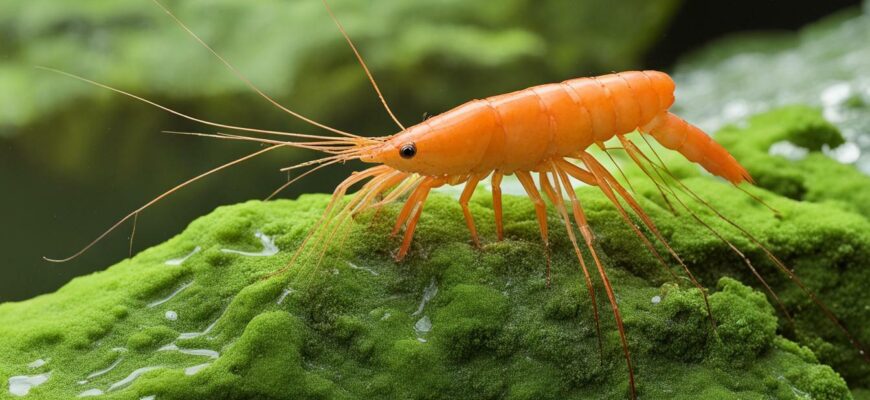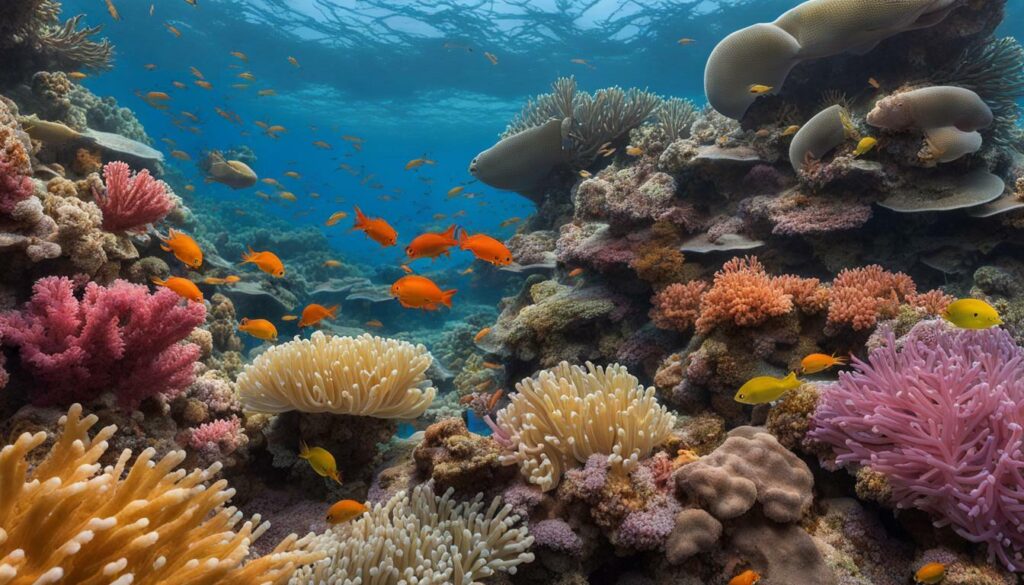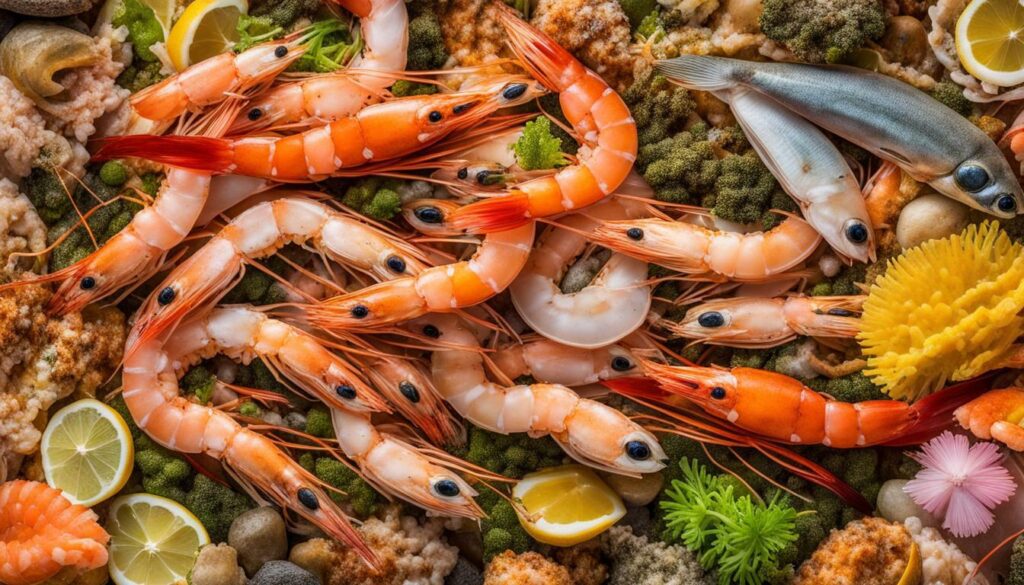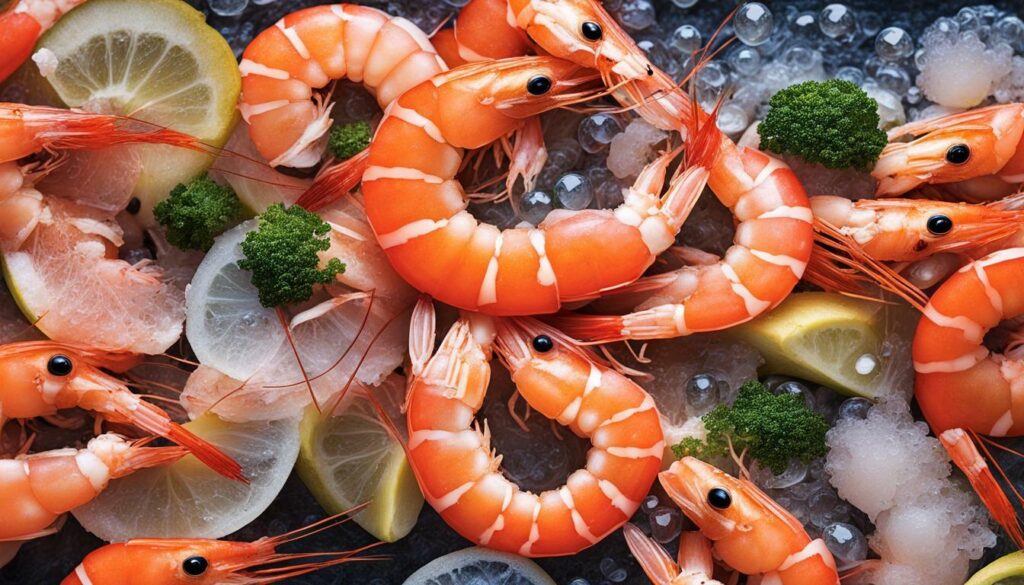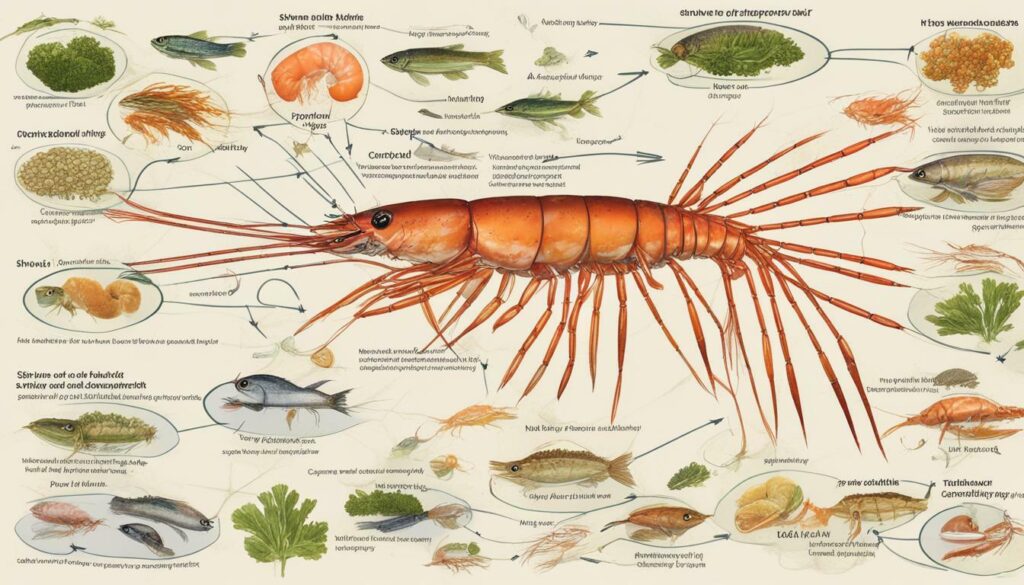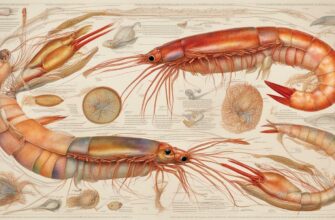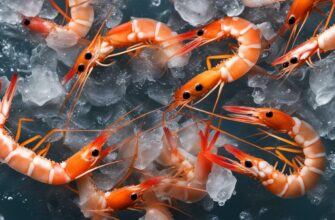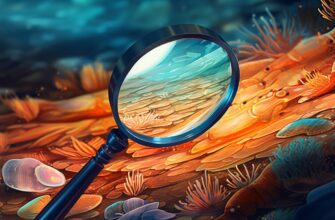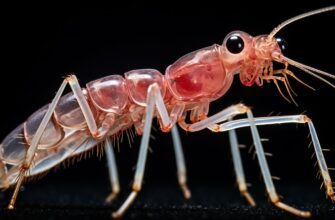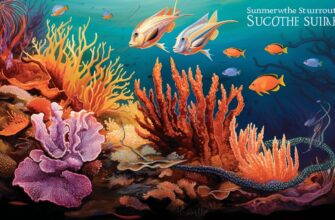Shrimps are fascinating creatures with unique dietary habits. As an aquarium owner or hobbyist, understanding what shrimps eat is crucial to promote their health and well-being. A balanced diet not only helps them to grow but also enhances their natural colors and their ability to reproduce. Let’s delve into the world of shrimp feeding habits and learn more about their dietary requirements.
- Key Takeaways:
- Shrimp Feeding Behavior
- Natural Food Sources for Shrimps
- Nutritional Needs of Shrimps
- Commercial Shrimp Diets
- Supplemental Foods for Shrimps
- Feeding Frequency and Quantity
- Observing Shrimp Feeding
- Factors Affecting Shrimp Feeding
- Conclusion
- FAQ
- Q: What do shrimps eat?
- Q: What are the feeding habits of shrimps?
- Q: What are the natural food sources for shrimps?
- Q: What are the nutritional needs of shrimps?
- Q: Are there commercial shrimp diets available?
- Q: What are some supplemental foods for shrimps?
- Q: How often and how much should I feed my shrimps?
- Q: Can I observe my shrimps during feeding?
- Q: What factors can affect shrimp feeding?
- Q: What is the importance of understanding shrimp feeding habits?
Key Takeaways:
- Shrimp diet and feeding habits significantly impact their overall health and well-being.
- Understanding the natural food sources for shrimps and their feeding behavior is essential.
- A balanced diet with essential nutrients, commercial diets, and supplemental foods can provide variety and ensure their nutritional needs are met.
- Observing their feeding habits and providing a conducive environment for optimal feeding is crucial for their health.
Shrimp Feeding Behavior
Shrimps are opportunistic feeders with a scavenging nature. They are constantly on the lookout for food, using their antennae to search for potential sources. Shrimps are active feeders, with some species feeding throughout the day, while others are more active at night.
Shrimps have a preference for algae, detritus, and plankton, which are the primary food sources available in their natural habitat. In aquariums, feeding habits can vary depending on the species and overall tank conditions.
It is essential to observe your shrimp’s feeding behavior to understand their preferences and feeding patterns. Some species may be more aggressive feeders than others, while some may require supplemental foods in addition to their main diet.
In some cases, shrimps may not consume all the food provided, which can lead to water quality issues. Overfeeding should be avoided, and any uneaten food should be removed after feeding to maintain a clean and healthy environment for the shrimp.
Tip: Providing a varied diet is essential to ensure your shrimp’s optimal health. Supplemental foods such as brine shrimp and daphnia can be offered to provide variety and meet their nutritional needs.
Natural Food Sources for Shrimps
Shrimps are bottom-dwelling creatures that feed on a variety of natural food sources found in their native habitats. These food sources play a crucial role in their diet, providing essential nutrients that promote their overall health and vitality.
| Food Source | Description |
|---|---|
| Algae | Shrimps feed on different species of algae, including filamentous and diatom varieties. Algae is an excellent source of plant-based protein, carbohydrates, and essential vitamins and minerals. |
| Plankton | Small aquatic organisms such as copepods, rotifers, and daphnia, collectively known as plankton, are a common food source for shrimps. These tiny organisms are rich in protein and lipids, making them an excellent source of nutrition for shrimps. |
| Detritus | Decaying organic matter, such as dead plants and animals, forms detritus, which serves as an important food source for shrimps. Detritus is high in protein and other essential nutrients, providing a balanced diet for shrimps. |
It’s important to note that the availability and quality of these food sources may vary depending on the location and season. For example, algae blooms may occur during certain times of the year, while plankton populations may fluctuate based on water temperature and salinity levels.
As such, it’s recommended to supplement a shrimp’s diet with commercially available foods that provide a balanced and varied diet. More on this in section 4.
Nutritional Needs of Shrimps
Like all living organisms, shrimps have specific nutritional requirements necessary for survival, growth, and reproduction. A balanced diet is crucial for maintaining their health and achieving optimal breeding results.
Protein: Shrimps require high levels of protein for growth and repair of body tissues. Protein also plays a crucial role in molting, the process of shedding their exoskeleton, which occurs frequently in young shrimps.
Fats: Dietary fats, in the form of phospholipids, are essential for the growth and reproduction of shrimps. These lipids are a major component of cell membranes and are necessary for intraovarian maturation and development of eggs.
Carbohydrates: Carbohydrates are the primary source of energy for shrimps. They are essential for metabolic processes such as cellular respiration and growth.
Vitamins: Shrimps require a variety of vitamins, including A, C, E, and B complex, for various physiological functions. Vitamin A is necessary for growth and maturation, while vitamin C plays a role in immunity and disease resistance. Vitamin E is essential for reproduction and survival, and B complex vitamins are necessary for metabolic processes.
Minerals: Shrimps require minerals such as calcium, magnesium, and phosphorus for skeletal structure and growth. Trace minerals like iron, zinc, and manganese also play important roles in various physiological functions.
Meeting the nutritional needs of shrimps is crucial for their health and well-being. Providing a balanced diet that includes protein, fats, carbohydrates, vitamins, and minerals will promote healthy growth, reproduction, and disease resistance. However, overfeeding should be avoided as it can lead to water pollution and other health problems.
Commercial Shrimp Diets
Commercial shrimp diets are readily available and can provide a convenient source of nutrition for your shrimp. These diets are formulated to meet the specific dietary requirements of different species of shrimp, making it easier to ensure they are getting all the necessary nutrients.
One advantage of using a commercial diet is that it can be less time-consuming than preparing live or frozen foods. Additionally, commercial diets can be more cost-effective in the long run, especially if you have a large shrimp population to feed.
It is important to note that not all commercial shrimp diets are created equal. Some may contain fillers or low-quality ingredients, so it is important to choose a high-quality diet from a reputable brand. Look for diets that list whole ingredients, such as shrimp or krill, as the first ingredient.
Another consideration when using commercial diets is the feeding frequency and quantity. Follow the manufacturer’s instructions on the packaging for the recommended amount to feed per day, taking into account the size and species of your shrimp. Be sure to monitor your shrimp and adjust the feeding amount as needed to prevent overfeeding, as excess food can lead to poor water quality and health problems for your shrimp.
Supplemental Foods for Shrimps
If you want to supplement your shrimp’s diet with additional foods, there are various options available. Offering a variety of foods can provide your shrimp with a balanced diet and can also add some excitement to their feeding routine.
Live Foods: Live foods are a great option, as they closely mimic the shrimp’s natural diet. Brine shrimp, daphnia, and mosquito larvae are popular choices. These foods are rich in protein and other essential nutrients that shrimps require for optimal health. They are available in most pet stores or can be easily cultured at home.
Frozen or Dried Foods: Frozen or dried foods are also convenient choices for supplementing your shrimp’s diet. These foods offer a longer shelf life and can be easily stored. Bloodworms, krill, and plankton are some popular options.
| Food Type | Pros | Cons |
|---|---|---|
| Live Food | Closely mimic natural diet; rich in nutrients | May introduce disease; more expensive |
| Frozen or Dried Food | Convenient and easy to store; long shelf life | May be less nutritious; less variety |
It is important to note that supplementing your shrimp’s diet should not replace their staple diet. These foods should be given as treats a few times a week, in moderation. Overfeeding can lead to poor water quality and even death.
Offering a variety of foods and observing your shrimp’s feeding behavior can help ensure they are consuming a balanced diet. Remember, a healthy diet is key to maintaining the overall health and well-being of your shrimp.
Feeding Frequency and Quantity
When it comes to feeding your shrimp, it’s important to keep in mind that they have a small stomach and can only eat so much at one time. Overfeeding can lead to health problems, such as obesity, and can also contribute to poor water quality.
As a general rule of thumb, adult shrimp should be fed once a day, but the quantity of food will depend on their species, size, and tank conditions. As a starting point, offer enough food that can be consumed within two to three hours. After that time, any uneaten food should be removed to prevent it from decomposing and polluting the water.
If you have young or growing shrimp, you may need to feed them more often to ensure they are getting the nutrition they need. However, be cautious not to overfeed and monitor their growth to adjust feeding frequency accordingly.
Remember, shrimps are scavengers and will also feed on algae, detritus, and other natural food sources in the tank, so they may not always rely solely on commercial or supplemental foods.
Tip: Use a feeding dish to regulate the amount of food you offer and to keep it contained in one area. This can help prevent overfeeding and make it easier to remove any excess food.
Observing Shrimp Feeding
Observing your shrimp during feeding can provide valuable information about their overall health and well-being. Shrimps are known to exhibit specific behaviors during feeding, which can indicate whether they are consuming enough food and whether their diet is balanced.
One common behavior to look for is the “feeding frenzy.” Shrimps will become more active and excited during feeding, often congregating around the food source and rapidly picking at it. This behavior is an indication that they are hungry and eagerly consuming the food.
Another behavior to observe is the “grazing” behavior, where shrimps will slowly pick at the food over an extended period. This behavior may indicate that the shrimps are getting enough to eat, but it may also suggest that they are not finding the food to be particularly palatable.
It’s also important to watch for any shrimps that are not participating in feeding or are exhibiting lethargic behavior. This could be an indication of stress or illness and may warrant further investigation.
By observing your shrimps’ feeding behavior, you can better understand their dietary needs and adjust their feeding regimen accordingly.
“Observing your shrimp during feeding can provide valuable information about their overall health and well-being.”
Factors Affecting Shrimp Feeding
Shrimps are sensitive creatures, and their feeding habits can be affected by various factors in their environment. Therefore, it is essential to create a conducive environment for optimal feeding habits. The following are some factors that can impact shrimp feeding:
- Water Quality: Poor water quality can lead to stress and sickness in shrimps, which can affect their appetite. Ensure that the water parameters are within the recommended levels, and regular water changes are conducted.
- Tank Mates: The presence of aggressive or predatory tank mates can lead to stress in shrimps, resulting in reduced feeding. Ensure that the tank mates are compatible with shrimps and do not pose a threat to their well-being.
- Stress Levels: Stressful conditions such as sudden changes in water parameters or overcrowding can affect shrimp feeding habits. It is crucial to maintain a stable and stress-free environment for shrimps to promote their feeding behavior.
By being mindful of these factors, you can help ensure that your shrimps are healthy and well-fed.
Conclusion
Understanding what shrimps eat is essential for ensuring their health and well-being. As we have explored throughout this article, shrimps have a scavenger nature and their feeding behaviors are influenced by their native habitats and tank conditions. Providing them with a balanced diet that meets their nutritional needs is crucial for their growth and survival.
From exploring natural food sources to commercial diets and supplements, we have discussed several options for providing shrimps with a healthy and varied diet. However, it is important to remember that moderation is key when it comes to feeding frequency and quantity to prevent overfeeding and resulting water quality issues.
Observing shrimp feeding behaviors and creating a conducive environment for feeding are also critical factors in ensuring their nutritional needs are met. Factors such as water quality, tank mates, and stress levels can impact their feeding habits, and should be taken into consideration when providing for their diet.
Overall, a balanced diet and a close eye on their feeding habits are essential to promoting the health of your shrimps. We encourage further exploration into shrimp feeding habits and the provision of a varied diet to keep your shrimps happy and healthy.
FAQ
Q: What do shrimps eat?
A: Shrimps are omnivorous creatures and have a varied diet. They eat a combination of algae, plankton, detritus, and small organisms that they scavenge from their surroundings.
Q: What are the feeding habits of shrimps?
A: Shrimps are known for their scavenger nature. They actively search for food by sifting through the substrate or grazing on surfaces. Their feeding patterns and preferences can vary depending on the species.
Q: What are the natural food sources for shrimps?
A: Shrimps rely on natural food sources found in their native habitats, such as algae, plankton, and detritus. These food sources provide essential nutrients and are crucial for their diet and overall health.
Q: What are the nutritional needs of shrimps?
A: Shrimps have specific nutritional needs and require a balanced diet. They need protein, vitamins, and minerals to thrive. Meeting their nutritional requirements is vital for their growth and overall well-being.
Q: Are there commercial shrimp diets available?
A: Yes, there are commercial shrimp diets available in the market. These diets are formulated to meet the nutritional needs of different shrimp species. They can be a convenient option for shrimp owners, but it’s important to consider their suitability and ingredients.
Q: What are some supplemental foods for shrimps?
A: Shrimps can benefit from supplemental foods such as live foods like brine shrimp and daphnia, as well as frozen or dried foods. Offering a variety of food options can provide additional nutrition and enrichment.
Q: How often and how much should I feed my shrimps?
A: The feeding frequency and quantity for shrimps can depend on their size, species, and tank conditions. It’s important to avoid overfeeding and provide moderation. It’s best to observe and adjust the feeding routine based on the shrimp’s behavior and appetite.
Q: Can I observe my shrimps during feeding?
A: Yes, observing shrimp feeding can be interesting and educational. You can watch for visual cues and behaviors exhibited by the shrimps during feeding. This can help you ensure that they are getting enough food and monitor their overall health.
Q: What factors can affect shrimp feeding?
A: Several factors can affect shrimp feeding, including water quality, tank mates, and stress levels. It’s important to maintain optimal water conditions, choose compatible tank mates, and create a stress-free environment for the shrimps to encourage healthy feeding habits.
Q: What is the importance of understanding shrimp feeding habits?
A: Understanding shrimp feeding habits is crucial for promoting their health and well-being. Providing a balanced diet that meets their nutritional needs ensures proper growth and development. It also helps prevent overfeeding and potential health issues.

